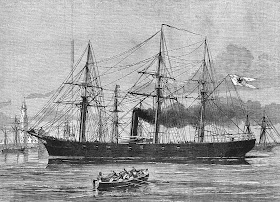a) The seizure of 200 Prussian merchant ships effectively prevented any sea borne imports into Prussia
b) Conversely, French naval dominance allowed unrestricted imports into France. This became especially important when the French capital was moved to Bordeaux after the fall of Paris, and arms imports from America kept the French armies supplied.
And what of the Prussian navy? In fact the three armoured cruisers did venture out on sorties in August and September 1870, only to not find any French to fight! The tiny sloop SMS Meteor (370 tons) fought a dramatic little duel with the slightly-less-tiny French ship, the Bouvet (800 tons) off Spanish Havana, their guns (both had only 3) unable to find a target in the high seas until the Bouvet tried to ram the Meteor. The resulting damage, and point blank gunfire, damaged both ships so much that they both limped back to Havana.
The SMS Meteor during her battle with the Bouvet, as painted by the German artist Christopher Rave.
The Meteor won fame and glory for Prussia, but it was left to the steam corvette the SMS Augusta to take the war to the French coast.
The voyage of the Augusta
The Augusta was a steam and sail powered corvette, with a crew of 230 and 8x 24 pdr and 6x 12 pdr guns. She had already had rather an eventful life. She had been built in France, with a Japanese name, the Osakka Yeddo, but actually intended for the Confederate navy, where she was due to be named the Augusta Mississippi. However, her delivery was vetoed by the French government, not wanting to get dragged into the American Civil War, which left a ship for sale. The Kingdom of Prussia, then at war with Denmark in the Baltic, snapped her up, naming her simply the Augusta.
The Augusta in 1864, flying the Prussian seekriegsflagge (naval flag)
The Augusta missed the Danish war, but from 1867-9 was sent to show the Prussian flag in the Caribbean. Well, actually the North German Confederation flag, but that was effectively the same thing. Whilst there her captain nearly caused a diplomatic incident with the US by starting to negotiate with Costa Rica over a possible naval base, although Bismark later claimed (vigorously, but not completely convincingly) that the captain was acting on his own initiative. Anyway, with war with France looming, she was ordered back to Wilhelmshaven.
In November 1870 the Augusta, under her captain Johannes Weickhmann, slipped out into North Sea. She steamed down the English Channel with no opposition and by December was at the mouth of the river Gironde, a few miles from the new French capital, Bordeaux. This daring act was rewarded with the capture of two merchant ships, the first captured by the Prussians in the war. Even better, she caused panic in Bordeaux, and Weickhmann toyed with the idea of steaming up the Gironde and bombarding the city, but turned back at the prospect of Fort Pate.
There was still fun to be had however. The Augusta sailed up the coast and anchored opposite Rochfort harbour where she picked off another prize. More embarrassingly for the French government her crew actually occupied for a time Fort Boyard. For anyone who has visited this sea-fort, or seen the tv show set there, this would seem impossible, but its 250 man garrison had been evacuated, handing an easy propaganda victory to the Prussians.
By now the Augusta was running out of coal, so she sailed down to the neutral Spanish port of Vigo. There her luck ran out and trapped by two French steam frigates, she stayed there until the war was over, her work done.
Aftermath
From 1874 to 76 the Augusta was back in West Indian waters. From 1877-8 she was even further afield, at Samoa in the Pacific where Imperial Germany (as her flag now proclaimed) had increasing commercial interest. After a respite back in Germany she was again sent to the Pacific in 1885, only to fall foul of a cyclone off the Gulf of Aden in 1885.
Rave.jpg)

No comments:
Post a Comment